Flavorful Flora: Enjoying Edible Flowers
Elevate your meals with blossoms from your garden
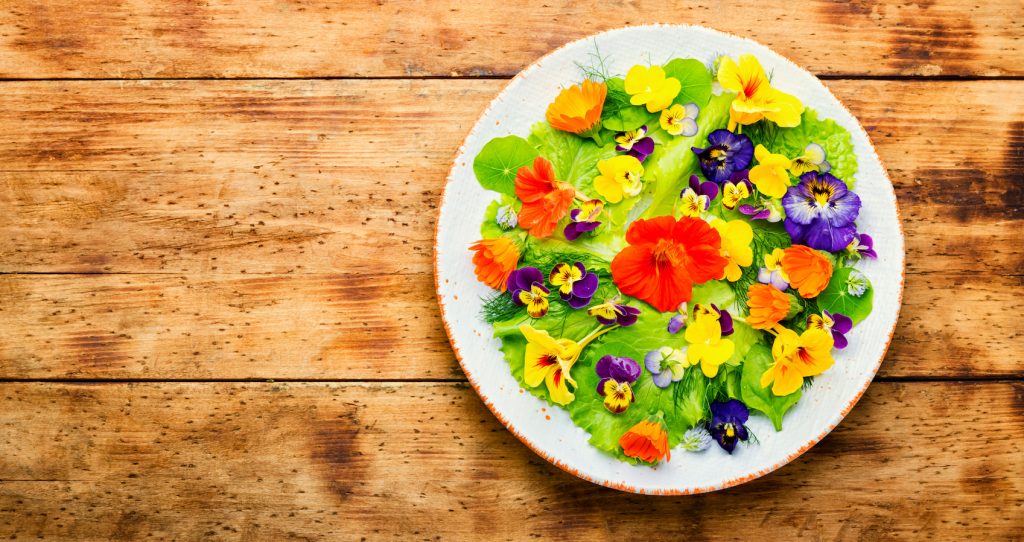 Have you ever noshed a nasturtium or tasted a tulip? Edible flowers can be such a delight to both the eyes and the palate. Some posies on a plate or in a dish elevate the appeal of the meal and enhance the invitation to dine.
Have you ever noshed a nasturtium or tasted a tulip? Edible flowers can be such a delight to both the eyes and the palate. Some posies on a plate or in a dish elevate the appeal of the meal and enhance the invitation to dine.
Eating flowers is making another comeback — not surprising for a practice with a long history. The Chinese incorporated daylily buds into their cuisine for centuries. Dianthus were used to make cordials in medieval times, and dandelion wine has been around for years. You may notice more edible flowers cropping up in meals.
I’ve been captivated by edible flowers for four decades and have found a floral enhancement in a meal makes guests feel special. They may comment about how much trouble you’ve taken. Rather than reply as I had for years that I just walked to my yard, now I say, “Oh, you’re worth it!”
A Few Possibilities
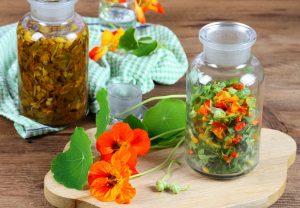
Nasturtiums are probably the first edible flower that comes to mind to most people. These colorful flowers have a peppery bite similar to arugula, and they’re a wonderful addition to salads.
The blossoms can also be used to infuse vinegar, imparting both color and flavor. Be sure to rinse and spin dry the blossoms before covering them with white wine vinegar, as water can cause cloudiness. Just strain out the spent blossoms after infusing and enjoy the enhanced vinegar in your salad or other dishes. For another use, try herbed cream cheese balls nestled in nasturtium centers — that’s a real showstopping appetizer.
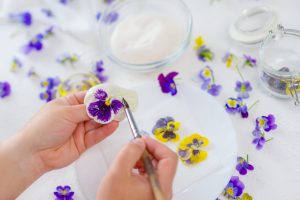
Other familiar edible flowers include all members of the viola family. Pansies, violets, violas and Johnny jump-ups are more than just pretty faces. They can be candied by painting them with egg whites, coating with a fine sugar, and then letting them dry. Candied flowers are a lovely adornment to a special cake. Freshly picked Johnnys perch pertly atop deviled eggs, or darker pansies smile through rice paper wraps of spring rolls, and wild violets make an exotic jelly. Plus all violas pop against a backdrop of salad greens.
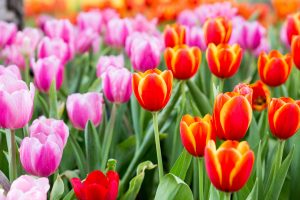
Perhaps surprisingly, tulips are edible and taste like peas. But unfortunately, the deer know how delicious tulips are as well. If you can rescue a few tulips from your garden to enjoy, carefully remove the center pistil and anthers, rinse, and then fill the cup with chicken or tuna salad for a dish that makes a lasting impression.
Another larger edible flower, daylilies delight when upended into a glass and filled with a scoop of sorbet, again, after clearing the center of pistil and anthers. They have a range of flavors from floral to metallic. I find the lighter yellow and peach colors taste better than the orange and deeper colors. As the name suggests, daylilies only last a day, so make the most of them!

Shortbread cookies take on a marvelous flavor when lavender is added to the mix. Lavender can overpower, so don’t add too much. Be sure to use only culinary lavender, as the wrong choice can add a camphor taste that’s unappealing. Another option: strawberry-lavender jam treats the palate to the sweetness of the strawberry with a lavender finish. And lavender is a wonderful addition to drinks.
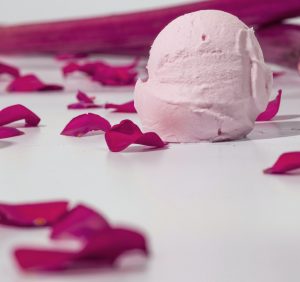
Even the humble rose can be candied, scattered over a dish, or made into a delicious ice cream. At the base of each petal is a white tip that ideally should be removed before use, as it tends to be bitter.
Can’t decide on one type of flower to add? Try flowerfetti, a mixture of fresh or dried flowers used to adorn cakes or sprinkled on cheeses and ice cream. Several different kinds of edible flowers can be combined to create the festive addition. Consider marigolds, cornflowers, roses, calendula and pineapple sage as just some of the possible combinations that give the feeling of a celebration.
Herbs and Vegetable Sources
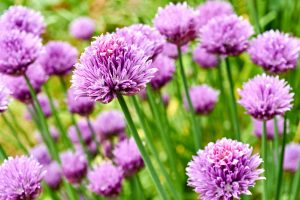
In addition to certain decorative flowers, the flowers of all culinary herbs are edible. Probably the best known are chive blossoms. Chives that bloom in late spring with their dazzling light purple orbs can be used for herbal vinegar, incorporated into butter, or just added for a colorful accent to a salad. The tiny florets should be separated, as consuming the entire blossom head at once gives an overwhelming onion flavor. Also consider garlic chive blossoms that grace August gardens. These florets are a lovely accent to soup, butter or a vegetable-laden white pizza appetizer.
Slipper-shaped flowers of peas and bean plants have a mild flavor of the vegetables they produce. Do remember that eating the attractive flower means no veggies are produced, so plant extra if you want both. Two varieties to try: the Sugar Magnolia pea has a bicolor lavender/purple bloom, and the scarlet runner bean lives up to its name with a brilliant red blossom.
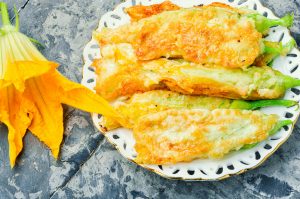
You’ve likely already enjoyed squash blossoms — perhaps stuffed with goat cheese, battered or fried. The female flowers grow close to the base of the plant, and the male flowers have a long stem. Picking the male flowers won’t sacrifice the squash production, but keep a few males for pollination. Careful harvest of a female flower attached to a developing courgette (French for zucchini) is a delicacy.
I hope you share my view that edible flowers are guaranteed to invite, excite and delight by enhancing any dining experience. Enjoy!
Words of Caution
There are a few rules to keep in mind as you begin your forage of flora.
Carefully consider where the flowers originated and how they were grown. Be certain the flowers are organically grown and pesticide free. Even flowers from your own garden need to be pristine to be safely edible.
No matter how inviting the flowers, begin by tasting them in small amounts, especially if you have allergies or asthma.
Take care to remove the pistils and stamens. In daylilies and tulips, these are easy to remove. But for small flowers, such as violas, it’s virtually impossible to remove all pollen (alert to the highly sensitive).
Roadside flowers have absorbed toxins and should not be eaten. Wildflowers are similarly suspect. Nor should flowers from a florist be eaten, since the origins and use of sprays are unknown.
Learn to identify poisonous plants — such as foxglove, oleander, lily of the valley — as well as the edibles. Use a trusted source or app to verify edibles.
And most important, if there’s any doubt whether it’s safe to eat, don’t!
The Philadelphia Unit of the Herb Society’s 86th Annual Herb Sale is on Thursday, May 8, 10 a.m. to 1 p.m., in the meadow at Historic Yellow Springs, rain or shine. Herbs at the sale are arranged alphabetically along the perimeter of the meadow around tables displaying specialty plants, including many scented geraniums and unusual salvias. Cash or check only. Stay for lunch and order a box lunch ($18, by Apr. 30) provided by Dixie Picnic. 610-993-3344; HSAPhiladelphia.org.
Our Favorite Resources
- B&D Builders
- Ball & Ball
- Berk Hathaway Holly Gross
- Berk Hathaway Kit Anstey
- Berk Hathaway M. Schwartz
- Canvas Valley Forge
- Dewson Construction
- DiSabatino Landscaping
- King Construction
- McComsey Builders
- Monument/Sotheby’s Int’l
- Mostardi Nursery
- Mountaintop Construction
- Renewal Dynamics
- Sheller Energy
- White Horse Construction
